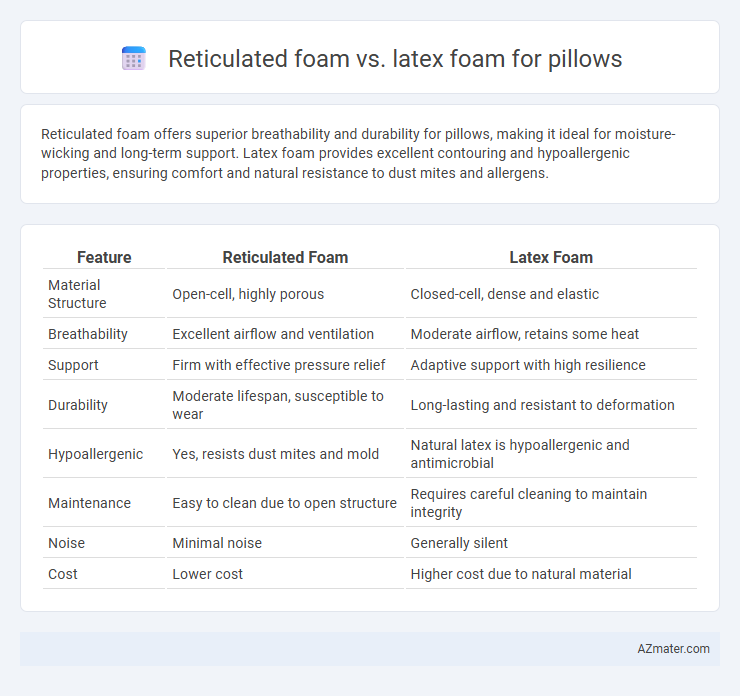Reticulated foam offers superior breathability and durability for pillows, making it ideal for moisture-wicking and long-term support. Latex foam provides excellent contouring and hypoallergenic properties, ensuring comfort and natural resistance to dust mites and allergens.
Table of Comparison
| Feature | Reticulated Foam | Latex Foam |
|---|---|---|
| Material Structure | Open-cell, highly porous | Closed-cell, dense and elastic |
| Breathability | Excellent airflow and ventilation | Moderate airflow, retains some heat |
| Support | Firm with effective pressure relief | Adaptive support with high resilience |
| Durability | Moderate lifespan, susceptible to wear | Long-lasting and resistant to deformation |
| Hypoallergenic | Yes, resists dust mites and mold | Natural latex is hypoallergenic and antimicrobial |
| Maintenance | Easy to clean due to open structure | Requires careful cleaning to maintain integrity |
| Noise | Minimal noise | Generally silent |
| Cost | Lower cost | Higher cost due to natural material |
Introduction to Reticulated Foam and Latex Foam Pillows
Reticulated foam pillows feature an open-cell structure that enhances airflow, making them highly breathable and moisture-wicking, ideal for hot sleepers. Latex foam pillows provide natural durability and resilience, offering consistent support while being hypoallergenic and resistant to dust mites. Both materials cater to different comfort preferences, with reticulated foam excelling in ventilation and latex foam excelling in supportive contouring.
Key Material Differences: Reticulated vs Latex Foam
Reticulated foam features an open-cell structure with high airflow and moisture-wicking properties, making it highly breathable and quick-drying compared to the denser, resilient latex foam. Latex foam, derived from natural or synthetic rubber, provides superior elasticity, durability, and hypoallergenic resistance, maintaining its shape and offering consistent support over time. The key material difference lies in reticulated foam's perforated network promoting ventilation, while latex foam emphasizes elasticity and comfort through its solid yet flexible material composition.
Breathability and Airflow Comparison
Reticulated foam provides superior breathability and airflow due to its highly porous structure with open cells that allow air to pass freely, making it ideal for cooling pillows. Latex foam, although naturally breathable and resistant to dust mites, features a denser cell structure that restricts air circulation compared to reticulated foam. For those prioritizing maximum ventilation and moisture-wicking properties, reticulated foam is the preferred choice over latex foam in pillow construction.
Comfort and Support: Which Foam Performs Better?
Reticulated foam offers superior airflow and breathability, enhancing comfort by reducing heat buildup during sleep, while providing firm, consistent support ideal for spinal alignment. Latex foam delivers a balanced combination of elasticity and pressure relief, contouring closely to the head and neck for personalized comfort without sacrificing support. For individuals seeking cooler sleep and durability, reticulated foam excels; those prioritizing natural responsiveness and gentle support often prefer latex foam.
Durability and Longevity of Each Foam Type
Reticulated foam offers high durability due to its open-cell structure that resists compression and maintains airflow, making it ideal for long-lasting pillow support. Latex foam provides superior longevity through its natural resilience and ability to quickly regain shape after pressure, ensuring consistent comfort over time. Both foams outperform traditional foam types in durability, with latex typically lasting 3-4 times longer than standard polyurethane foam, while reticulated foam excels in maintaining breathability and structural integrity.
Hypoallergenic Properties and Allergen Resistance
Reticulated foam offers superior breathability and moisture resistance, reducing the buildup of dust mites and allergens, making it highly hypoallergenic and ideal for allergy sufferers. Latex foam is naturally antimicrobial and resistant to dust mites and mold, providing excellent allergen resistance for sensitive users. Both materials promote a healthier sleep environment, with latex offering natural resistance and reticulated foam excelling in ventilation.
Moisture Management and Washing Ease
Reticulated foam offers superior moisture management due to its open-cell structure that promotes enhanced airflow and quick drying, making it highly resistant to mold and mildew. Latex foam, while naturally antimicrobial and hypoallergenic, retains more moisture because of its denser structure, which can slow drying times after washing. Reticulated foam is easier to clean and dries faster, whereas latex foam requires more careful washing and longer drying to maintain its durability and shape.
Environmental Impact and Sustainability
Reticulated foam, made primarily from polyurethane, often involves petrochemical processes with higher environmental footprints compared to natural latex foam, which is derived from rubber tree sap and offers better biodegradability and renewability. Latex foam is more sustainable due to its longer lifespan and organic origin, minimizing landfill waste and reducing overall carbon emissions. Reticulated foam's production and disposal contribute to pollution and resource depletion, while latex foam supports eco-friendly practices through renewable harvesting and potential for recycling.
Price Comparison and Value for Money
Reticulated foam pillows generally cost less than latex foam pillows, offering an affordable option for those seeking good breathability and support. Latex foam, though priced higher due to its natural materials and durability, provides superior resilience and hypoallergenic properties, often resulting in longer lifespan and enhanced comfort. Evaluating value for money depends on preference for budget-friendly options versus investment in premium materials that maintain shape and comfort over time.
Choosing the Right Foam Pillow for Your Needs
Reticulated foam offers superior breathability and moisture-wicking properties, making it ideal for hot sleepers or those prone to allergies, while latex foam provides excellent support, durability, and natural hypoallergenic qualities suited for individuals seeking firm yet comfortable pillows. Both foams vary in density and resilience; reticulated foam has an open-cell structure promoting airflow, whereas latex foam offers consistent support and pressure relief with its dense, elastic composition. When choosing the right foam pillow, consider factors such as sleep position, temperature sensitivity, and the need for allergen resistance to match your personalized comfort and health requirements.

Infographic: Reticulated foam vs Latex foam for Pillow
 azmater.com
azmater.com